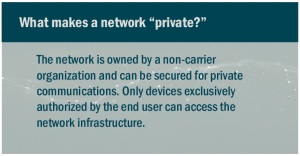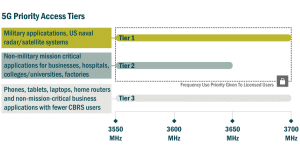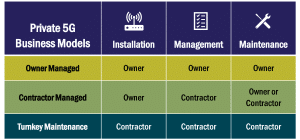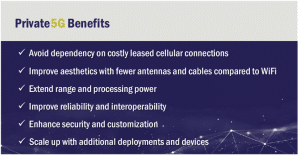Private Networks Get Ready for 5G Evolution
The rollout of fifth-generation wireless network technology (5G) opens a new band of cellular networks offering faster connectivity for larger volumes of data.
Mobile carriers are gearing up, widely advertising 5G benefits to the general public. Yet the users who will fully maximize its opportunities will most likely be private enterprises.
In preparation, companies, municipal agencies and institutions are imagining the new opportunities offered by having a 5G network of their own. Technologies and standards behind “Private 5G” are taking shape. For high-security facilities that rely on sensitive, interconnected technologies, the impact could be transformational.

With Access Comes Opportunity
Up until now, the advent of 4G Long Term Evolution (LTE) mostly benefited mobile consumers, streaming content and connecting to affordable cellular access wherever they roam. Implementation impediments have held back its potential for large enterprises.
4G LTE is limited in its ability to serve locations with a high density of users such as at concerts or sporting events.
The opportunity to develop private LTE networks began when a 150MHz spectrum band that stretches between 3.55-3.7GHz was taken from two LTE bands. The Federal Communications Commission announced in 2015 that the Citizens Broadband Radio Service (CBRS), utilizing spectrum previously limited for military and government-approved uses, would become available for public and private organizations.
Since then, industry groups have been developing a CBRS framework to establish a set of protocols for various users of the spectrum. CBRS now forms the basis of very fast, highly secure, expansive cellular networks for private use.

Fast, Secure, Customizable Coverage
Similar to an enterprise-level Wi-Fi network, a CBRS network can be highly customizable and provide extensive amounts of data regarding the network’s performance, end devices and usage — none of which carriers provide for leased devices on their cellular networks.
Private 5G networks offer the promise that network configurations can be tailored to the unique needs of a specific facility and its operations.
Like 4G CBRS, private 5G networks offer the promise that network configurations can be tailored to the unique needs of a specific facility and its operations. Potential benefits depend on the installer-integrator contract agreement, system design, vendor solution and services, and the neighboring users of the spectrum.
Compared with traditional cable, Wi-Fi networks and leased license cellular connections, a 5G CBRS network can generally offer:
- Functionality practically independent of total users. 5G dramatically increases capacity over 4G networks. Even when high-traffic areas such as an airport or hospital are at full capacity, uninterrupted coverage can continue for security, facility management or mission-critical applications.
- Precisely targeted coverage. High reliability can be assured regardless of location, whether outdoors such as on a remote airfield or indoors such as in an underground train station.
- Reduced costs. Enterprises avoid the costs of leased cellular connections and the installation and operation of on-site wired infrastructure.
- Tailored security measures. Strict security, privacy and data isolation requirements can be controlled within the enterprise, allowing users to customize the network while coexisting with public access 4G or 5G carrier networks.
- Predictable transmission. Delay and error rates are highly predictable. Interconnected software can more easily compensate, allowing for greater functionality of automated devices.
Private 5G Use Cases
Early adopters will likely consist of enterprises that manage controlled, sensitive and secure environments, where smart building technologies, autonomous devices, and continuous inventories of visitors or materials all depend on reliable network connections.
Airports
Increasingly reliant on smart technologies for tracking passenger flow, monitoring security threats, coordinating air traffic, and managing ground service equipment, airports are already exploring 5G applications. Finland’s Helsinki Airport became the first airport to launch a dedicated 5G network in 2018. An autonomous 5G-powered robot monitors the airport’s terminal area and guides passengers to their gates. In the United States, Houston Airport System is among airport operators preparing a 5G Readiness Plan.
42% of surveyed healthcare providers have plans for 5G deployments.
Healthcare
Traditionally slower to digitize operations, the healthcare sector may not move as quickly as other industries. Once 5G takes off, however, healthcare is forecast to be the largest of likely private 5G markets. Services that will benefit include telemedicine and imaging, as well as new advances such as remote monitoring of wearable devices, incorporation of video analytics into hospital security, and drone technologies. Rush University Medical Hospital in Chicago is installing a 5G hotspot in one facility simply due to space constraints that limit installation of new Local Area Network (LAN) cables.
Greenfield Construction
More immediately, private 5G is well suited for a wide range of new construction projects. In addition to logistics hubs and manufacturers, likely deployments include any campuses built to serve large enterprises. By installing 5G CBRS networks with fully owned infrastructure and their own dedicated spectrum, a private owner could reduce traditional infrastructure costs for installing cables and other equipment involved in wired and Wi-Fi networks. Rush Hospital, for example, is designing a new 11-story outpatient facility that would feature a private 5G network.
Potential Business Models
Installing a 5G CBRS network begins with deciding on the business model best suited to an enterprise’s operations. Private 5G design options include three possible models if relying on network assets owned by the enterprise.

- Owner installed, managed, and maintained
Taking full ownership of a CBRS network will involve designing, installing, managing and maintaining the entire network and its devices, as well as training and certifying the enterprise’s workforce.
- Owner installed, contractor managed and maintained
Retaining full control, enterprises may wish to hire a contractor to design and install the network and provide maintenance support.
- Turnkey with maintenance contract
Avoiding the upfront capital and operational costs, enterprises may wish to take a “hands-off” approach and delegate responsibilities for installing, maintaining and managing the network. Revenue-generating strategies to offset the service costs include sharing the network with tenants — as some airports do with their Wi-Fi networks.
Unleashing the Next Generation of Innovation
To benefit from the advances of 5G, private enterprises can choose to connect to the public carrier networks. But for many of the world’s largest enterprises, private 5G will likely become the preferred choice.

More than 100 companies are estimated to have begun testing private 5G deployments worldwide, according to recent market analysis. Hundreds of thousands are expected in the coming decade. By 2024, tens of billions of dollars in annual spending are anticipated for cellular mobile equipment and services across private networks.
If these forecasts materialize, 5G may be the first generational mobile technology to impact enterprises more than consumers. Although private 5G standards still need to be finalized, forward-looking enterprises are already getting ready. Private-sector innovation is likely to flourish, creating new business models, new services and a new generation of technology applications.


